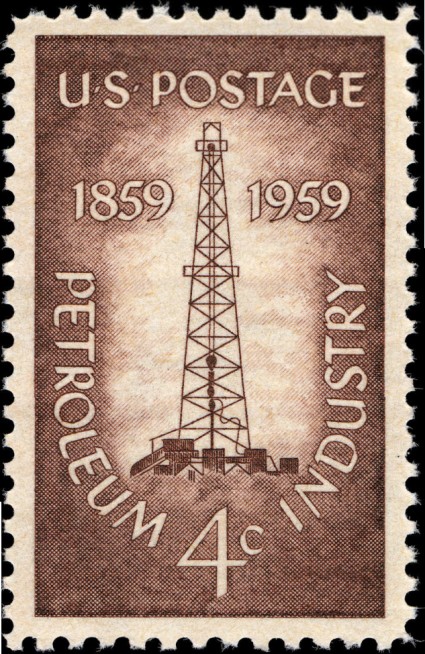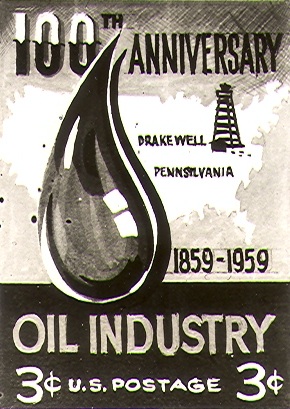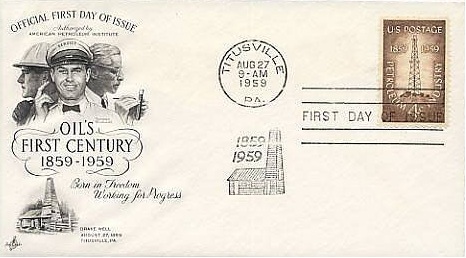Postal Service commemorates U.S. petroleum history centennial with 120 million stamps.
A centennial oil stamp commemorating the birth of the U.S. oil and natural gas industry was issued on August 27, 1959, by Postmaster General Arthur Summerfield, who proclaimed: “The American people have great reason to be indebted to this industry. It has supplied most of the power that has made the American standard of living possible.”
As the sesquicentennial of the first U.S. well drilled to produce oil approached in 2009, a special “Oil 150” committee sought U.S. Postal Service approval for a commemorative stamp. The committee and historians in more than 30 petroleum-producing states petitioned for a stamp similar to one issued for the industry’s 1959 centennial of the first commercial U.S. oil well.

Millions of stamps commemorating the U.S. petroleum industry’s 1959 centennial served, “as a reminder of what can be achieved by the combination of free enterprise and the vision and courage and effort of dedicated men.”
In 1959, more than 120 million four-cent “Petroleum Industry” stamps were issued as gasoline service stations nationwide hosted special events and petroleum-related communities proudly hosted centennial parades. The Smithsonian Institution’s Museum of American History in 1967 devoted an entire wing to oilfield exhibits — the Hall of Petroleum.
However, despite the effort of the Oil 150 Steering Committee of Oil City, Pennsylvania, the U.S. Postal Service Citizens’ Stamp Advisory Committee rejected creating a stamp to recognize the 1859-2009 anniversary of the nation’s petroleum industry.
Committee Co-Chair Rep. John E. Peterson (R-Pa.) later explained why advisory committee members rejected the request: “Unfavorable public impressions of the modern oil industry.”
The rejection of a petroleum-related commemorative stamp contrasted attitudes in 1959, which recognized the significance of the industry and its Oil Creek discoveries 100 years earlier.
1959 Oil Celebrations
U.S. Postmaster General Arthur Summerfield, the keynote speaker at the August 27, 1959, “Oil Centennial Day” in Titusville, Pennsylvania, dedicated a four-cent commemorative postage stamp.
At the Drake Well Memorial Park in Titusville, popular NBC Today Show host Dave Garroway broadcast live as thousands of guests crowded the grounds. At the time, gasoline cost 30 cents per gallon — and the accomplishments of the petroleum industry were cause for national celebration.
The Today Show morning program included an oil well “shooting” demonstration at the park. Featured speakers that day included Pennsylvania Governor David Lawrence and Texas Railroad Commission Chairman Gen. Ernest Thompson.
According to the Titusville Herald, more centennial speeches followed the ceremony, and more than 400 guests attended a luncheon at the Titusville High School cafeteria. That evening, a 50-minute fireworks display capped several days of celebrating the petroleum industry — and the man who had struck oil exactly 100 years earlier.

Pennsylvania artist Robert Foster submitted several designs for the 1959 commemorative stamp.
Although known as “Colonel” Edwin L. Drake in his day, the title originated with executives at the Seneca Oil Company. They thought it would add prestige to their speculative drilling venture.
As part of the ceremonies 100 years later, the Pennsylvania National Guard formally commissioned Drake a colonel. His granddaughters, Mrs. Marie Drake Carver and Mrs. Grace Drake Kilch, accepted the commission certificate.
A year earlier, in 1958, the seven members of the newly formed Citizens’ Stamp Advisory Committee had finally responded to the tenacious efforts and recurring calls from a local citizens group formed as the Oil Centennial, Inc.
With input from the American Petroleum Institute (API), the Colonel Drake Philatelic Society, and Pennsylvania oil companies, the U.S. Post Office Department announced a commemorative stamp. The oil stamp was to be one of only five commemorative stamps issued that year.
Artist Robert Foster was chosen to design the stamp’s vignette. Foster, best known for his stainless steel sculpture of Mercury on the Ford Building at the 1939 New York World’s Fair, submitted several designs. The Titusville Herald noted that one of his original designs included a representation of the Drake Well.
“Being an artist (and a Pennsylvanian), I was so familiar with the Drake Well that I could draw it from memory, without even looking at pictures,” Foster noted.

A Norman Rockwell illustration accompanied the issuance of four-cent stamps commemorating the petroleum industry’s centennial. Collectors prize first-day cachets like the one above from Titusville, Pennsylvania.
Artist Robert Foster was chosen to design the stamp’s vignette. Foster, best known for his stainless steel sculpture of Mercury on the Ford Building at the 1939 New York World’s Fair, submitted several designs. The Titusville Herald noted that one of his original designs included a representation of the Drake Well.
“Being an artist (and a Pennsylvanian), I was so familiar with the Drake Well that I could draw it from memory, without even looking at pictures,” Foster noted.
The final design used a more modern drilling rig image, the Herald article noted, “because of its higher recognition value,” since many people may not know the Drake Well, but they would “recognize a modern-looking oil derrick when they see one.”
Postmaster Summerfield selected the final design and the Bureau of Engraving and Printing produced four plates for the stamps. The plate numbers – 26416, 26417, 26419, and 26431 – appear on blocks of the commemorative issue, known to philatelists as the plates that produced all the petroleum centennial stamps and identified as “Scott (Catalog number) 1134.”
“We look to this stamp as more than a commemorative symbol. With more than 120 million stamps to be issued, it will go throughout the world as a reminder of what can be achieved by the combination of free enterprise and the vision and courage and effort of dedicated men,” declared Summerfield.
The first day of issue resulted in 801,859 of the stamps mailed from and canceled in Titusville, including many with a special cachet illustration “Born in Freedom, Working for Progress” created by artist Norman Rockwell.
Summerfield concluded his remarks to the crowd in Titusville by declaring the stamp “will serve as a worldwide tribute to all who have brought the oil industry to its present greatness – and to its leaders who are moving with confidence to meet the challenge of the future.”
2009 Petroleum Stamp Rejection
Public perceptions may have changed greatly since 1959, but not the significance of the 1859 discovery of Edwin L. Drake, father of the American petroleum industry.

The U.S. Postal Service commemorated Kermit the Frog and nine of his Muppet friends in 2005.
Although the Postal Service Stamp Advisory Committee turned down requests for one 150th anniversary oil stamp design, it earlier granted stamps to Kermit and nine of his popular Muppet friends. The failed attempt to commemorate the petroleum industry was not unique.
In 1934, efforts to recognize the industry’s 75th anniversary, its diamond jubilee, did not succeed. In 1949, Senate Bill 1098 provided for issuance of a commemorative stamp for the 90th anniversary .
Senate Bill 1098 did not pass, but the setback did not stop Titusville and many other oil patch communities from celebrating their local heritage in 1949 and later years. National recognition of the industry’s key role in modern society did arrive in 1959, and oil centennial stamps have been preserved by the American Philatelic Research Library, Bellefonte, Pennsylvania.
_______________________
Recommended Reading: Black Gold: The Philatelic History of Petroleum (1995); Myth, Legend, Reality: Edwin Laurentine Drake and the Early Oil Industry
(2009); The Prize: The Epic Quest for Oil, Money & Power (1991); The Extraction State, A History of Natural Gas in America (2021). Your Amazon purchase benefits the American Oil & Gas Historical Society. As an Amazon Associate, AOGHS earns a commission from qualifying purchases.
_______________________
The American Oil & Gas Historical Society (AOGHS) preserves U.S. petroleum history. Please become an AOGHS annual supporter and help maintain this energy education website and expand historical research. For more information, contact bawells@aoghs.org. © 2023 Bruce A. Wells. All rights reserved.
Citation Information – Article Title: “Centennial Oil Stamp Issue.” Authors: B.A. Wells and K.L. Wells. Website Name: American Oil & Gas Historical Society. URL: https://aoghs.org/petroleum-art/centennial-oil-stamp-issue. Last Updated: August 22, 2024. Original Published Date: December 1, 2007.



